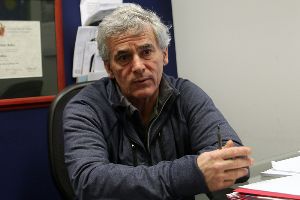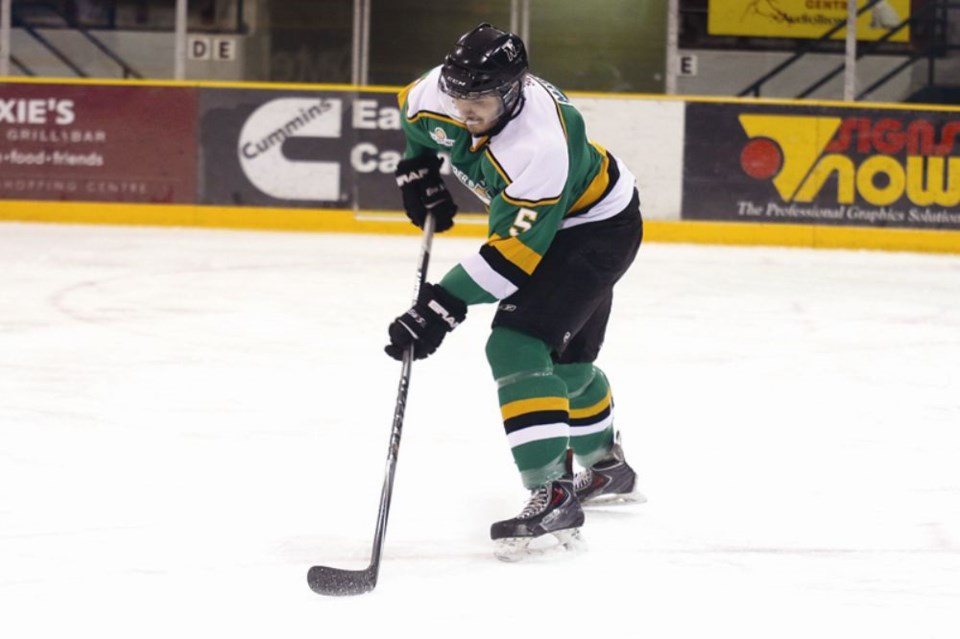Debilitating headaches, unrelenting dizziness and a harsh sensitivity to light.
Those are all things that 19-year-old Bryce Martyn has endured as a result of his passion for playing hockey
Martyn, now a defenceman for the Thunder Bay North Stars in the Superior International Junior Hockey League, estimates he has suffered five concussions in his young life.
It was in September 2014 when his playing days nearly came to an end. Martyn was trying out for the Hamilton Red Wings of the Ontario Junior Hockey League.
He didn’t see his opponent’s stick until it smashed into his face, knocking out five teeth and sending him flying backwards, where his head bounced off the ice.
“I got right up but I was dizzy. I went straight to the room and it just hit me like a brick wall,” he says.
“I could feel my heartbeat in my eyes. You could see it and it’s really a different feeling…It’s a scary feeling.”
After being evaluated in the locker room Martyn was taken to the hospital, where he remembers spending the next four hours.
The following weeks were excruciating as he suffered headaches that were aggravated by flying home to Thunder Bay and the dental surgeries to replace his teeth.
It made Martyn question the value of continuing to play hockey and he stepped away for half a year.
“It makes you see a whole different perspective on life,” he says.
“What’s more important, the game or having a full life and enjoying it?”
A concussion is formally known as a mild traumatic brain injury which can occur either as a result of direct impact or a jolting force that causes sudden head movement, shifting the brain and causing impact with the skull.
But physician David McKee, who operates the sports concussion clinic at the Lakehead University Sports Medicine Clinic, said the classification is a misnomer.
“It is not a mild injury. The symptoms can persist and they can be life-long symptoms,” McKee says.
Those include physical symptoms such as headaches, dizziness, nausea, vomiting and light and noise sensitivity. There are cognitive symptoms such as difficulty focusing and concentrating and sleep issues such as afternoon fatigue and difficulty falling sleeping at night.
More troubling are the potential mental health symptoms like depression, anger, irritability and anxiety.
 Since November, McKee and concussion clinic coordinator Alyssa Bachorski have tracked sports related concussions and have treated more than 100 injuries during that time.
Since November, McKee and concussion clinic coordinator Alyssa Bachorski have tracked sports related concussions and have treated more than 100 injuries during that time.
While they have seen injuries from expected contact sports like hockey and football, they have also treated a number of athletes from sports where concussions might not be thought of as a common injury.
“We do see a mixture of causes and it’s not just hockey and football like we think,” McKee says. “There are other sports that are high-risk such as basketball, soccer, cheerleading and wrestling as well.”
The concussion issue is one that has the attention of the organizations overseeing youth sports.
In recent years Hockey Canada has implemented a number of rule changes designed to protect players, such as legalizing body checking at the older bantam level, instead of peewee. Also, the nation’s central governing body for hockey has outlawed checking to the head in games as it now results in an automatic penalty.
Every team is required to have a trainer who has undergone a certification process that includes concussion awareness that follows Hockey Canada’s six-step returning to play program.
Hockey Northwestern Ontario president Trevor Hosanna acknowledged the emerging discussion around concussions is a threat to the future of the game.
“We definitely hear it and it’s on the radar for one of the causes that decreases registration,” Hosanna says.
“We think some of these things Hockey Canada is doing with the education and rule changes are hopefully helping to make the game safer. I’m sure there are still areas we can improve the game but I think they’ve made some pretty good strides in the past couple of years to reduce contact to the head.”
The awareness of the dangers of concussions started from the professional ranks with a trickle down that has turned into a waterfall, heightened by superstar Sidney Crosby missing nearly the full 2011 year from lingering concussion symptoms.
The days of hulking National Hockey League blueliners such as Scott Stevens dishing out thunderous hits to unsuspecting opponents, who are left struggling to stand up to skate back to their bench, are nearly gone as younger players are being taught how to avoid those vulnerable situations.
“I think you’ve seen a shift in the game to focus on more skill and maybe not so much the rough, physical play that was there,” Hosanna says.
“There’s always going to be body checking and body contact but I think players are using their skills and abilities to learn to protect themselves better.”
The sports concussion clinic has developed a partnership a number of hockey teams and organizations with the Thunder Bay Kings and Thunder Bay Queens youth teams, as well as the SIJHL and the Lakehead Thunderwolves.
Those teams, along with the Thunder Bay Minor Football Association and Superior Secondary Schools Athletic Association, require players over the age of 14 to take an ImPACT neurocognitive test at the beginning of the season.
“It gives us a baseline of their functioning and if they do have a head injury we can compare it to that,” McKee says.
The hope is to expand that to other sports, such as the local alpine skiing team.
It’s particularly important to be able to identify a concussion to prevent athletes from returning to sport too early and putting themselves in further danger.
“Repetitive head injuries, two or more, then yes, you are thought to be at an increased risk for development of symptoms and for symptoms to be prolonged in its recovery,” McKee says.
More than a year after he contemplated an end to his hockey career, Martyn knows the risks now more than ever.
While he’s symptom free and remains on the ice, he knows the impact one or two more major hits could have on the rest of his life.
“I was scared, that’s for sure. It’s a big thing to lose,” Martyn says.
“It’s the most important thing, being able to remember memories and good times with your friends."
